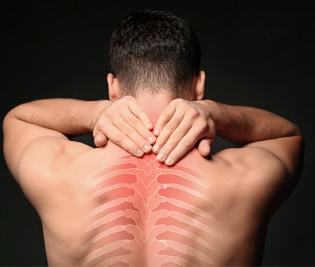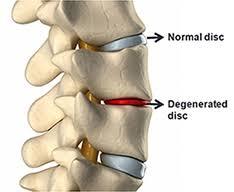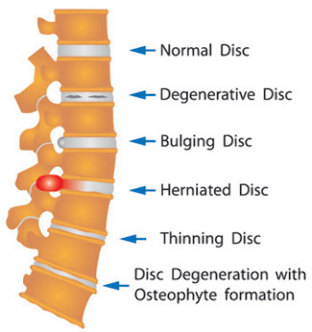
Disease degenerative disc disease is the most prevalent disease of all diseases of the spine. As low back pain, directly represents dystrophic-degenerative discs located between the vertebrae, as a consequence, this leads to their irreversible change in the structure and shape of the disks themselves.
With increasing age these changes in his spine are developing more and more, and by the age of about 40...45 osteochondrosis sick almost all. By itself, the osteochondrosis of the thoracic spine develops much less frequently than lumbar or cervical spine, as the vertebrae are much less mobile than in other vertebral areas. In addition, the back area in the area of the chest is more developed corset of muscles that support the spine in the thoracic spine is much better than the other.
What is thoracic degenerative disc disease?
Thoracic osteochondrosis directly represent the stratification of the discs between the vertebrae, while decreasing their thickness and, as a consequence, the subsequent pinched nerve endings located in the intercostal area of the chest of a man.
However, we note again that because of the physiological fixation of the ribs in humans is quite rigid, the spine in the chest area less subject to disease osteochondrosis.
Usually this process pathology involving the discs between the thoracic vertebrae twelve thoracic vertebrae. But most often, osteochondrosis of the thoracic pathological changes in Wernigerode vertebrae. There are several degrees of lesions in breast osteochondrosis, and then we will consider them in more detail.
Predisposing factors in the development of thoracic degenerative disc disease
The exact causes of degenerative disc disease of the thoracic modern science until the end is not yet established. At the moment, decided to allocate in the medicine the following predisposing factors or so called - risk factors:
- genetic predisposition;
- excessive physical load;
- injury of the spine, such as, for example, falls or injuries;
- changes that occur with age, intervertebral discs, and resulting in a decrease in hydration in the tissues of the disc;
- circulatory disorders in the chest.
The reasons for disease is osteochondrosis of the thoracic spine
In the main degree the development of the disease osteochondrosis, in General, contributes to physical inactivity, i.e. lack of muscle loads, leading to the weakening of the functions of the muscular system and, consequently, to higher loads on the intervertebral discs and ligaments.
Other, additional reasons for the development of thoracic osteochondrosis are as follows:
- hypothermia;
- the presence of chronic stress situations;
- infection;
- conditions of heavy physical labor;
- resulting hormonal disturbances in the body;
- violation of metabolism in the body;
- congenital defects of the spine.
During the impact of the combination of these factors, or sometimes even one in the discs between the vertebrae over time and develop dystrophic-degenerative irreversible processes:
- purposee the nucleus of the intervertebral disc begins to lose fluid, which was allocated to them to provide a lubricating function, which ultimately reduces the cushioning function of the disc;
- further, the fibrous ring vertebrae themselves, in view of increasing the load on it becomes more vulnerable, which, in turn, leads to its gradual destruction.

Symptoms of thoracic degenerative disc disease and its symptoms
Clinical symptoms of thoracic osteochondrosis are completely dependent on such factors as:
- the age of the patient;
- the extent of damage the disease;
- stages of degenerative disc disease of the thoracic spine: remission or exacerbation.
The main symptoms of osteochondrosis of the thoracic are:
- pain in the chest or in the spine, so-called, Dorigo;
- the painful nerve damage of the spinal cord – radiculopathy;
- abdominal syndrome;
- cardiac syndrome or changes the heart muscle, characterized by pain, continuing even under the influence of nitroglycerin;
- pulmonary syndrome, in the form of pulmonary congestion with signs of hypoxia, that is, suffocation.
The increase in body temperature in a patient with thoracic osteochondrosis is not observed, which is also a direct differential diagnostic sign. Dorsalgia in the chest area indicates the occurrence of cracks in the fibrous ring and the deformation of the nucleus pulposus. When conducting palpate, pain the chest only intensified.
In addition, the characteristic symptoms of osteochondrosis of thoracic compressive myelopathy, that is, deformation of nerve endings, are:
- the feeling of "chills" - paresthesia;
- pain along the squeezed nerve;
- reduction of sensitivity of temperature and touch;
- back disorders of motor function.

The extent of the disease thoracic degenerative disc disease
Different stages of the disease, thoracic osteochondrosis are characterized by their each pathology, each of which is inherent only their clinical signs. Modern medicine there are four degrees of degenerative disc disease of the thoracic and, accordingly, four periods of its development. Take a closer look.
First degree, which is characterized is that the inside of the fibrous ring cracks, which subsequently penetrates purposee core. This period of development of the disease thoracic degenerative disc disease is characterized by the following features:
- the appearance of pain in the spine at the place of his defeat, but does not extend beyond the localization of the occurrence of the disease;
- these pains can be of a permanent character, and to be in the form of crosses;
- can occur spasmodic contraction of the muscles accompanied by pain in the cardiac region.
Second degree, as the period of development of thoracic osteochondrosis, is characterized by abnormal appearance of increased intervertebral mobility with the following clinical manifestations:
- appear subluxations in the thoracic spine;
- pain worsens during movement;
- appear uncomfortable when long-lasting position.
Third degree, characterized by a period when the fibrous ring is broken and beyond it goes purposee core. In this period of the disease osteochondrosis of the thoracic spine begin to appear herniated discs, clinical signs which are quite heavy. Namely, neuro-vascular, muscular-tonic and reflex dystrophy.
In addition, a third-degree degenerative disc disease of the thoracic is characterized by changing the following conditions of the spine:
- poor fixation of the provisions of the spine;
- the limitation of the spinal division, manifested in the form of kyphosis or scoliosis.
The fourth degree, associated with the period in which dystrophic-degenerative process affects all structures located in the surrounding of the spine. This pathological involved yellow, and other interspinal ligaments and the structures surrounding the spine, there is a fibrosis. In this period of the disease thoracic degenerative disc disease, clinically observed, the so-called remission.
Complications that can occur when breast osteochondrosis
With further progression of the disease thoracic degenerative disc disease may develop related complications such as:
- inflammation of the nerve endings of the spinal cord;
- the occurrence of intervertebral hernias;
- the development of vascular dystonia;
- the development of schmorl's nodule;
- disease spondylosis;
- pathological growth of bone growths - osteophytes;
- a significant decrease in the spinal canal.
It should be noted that the severity of complications when breast osteochondrosis fully depends on the pace of progress of the arising of the disease and, of course, from the effectiveness of the methods of treatment of osteochondrosis of the thoracic spine.

Diagnosis of thoracic osteochondrosis and its methods
In practice, several methods are used for the diagnosis of thoracic osteochondrosis. Of these the most common is x-ray examination, the results of which are quite informative. Symptoms of thoracic degenerative disc disease identified in this study are:
- the broken contours of the discs between the vertebrae;
- the edges of the cover plates was purchased undulating character;
- the intervertebral discs change their shape;
- the resulting osteophytes – bony abnormal growths;
- enlarged and sharpened hook-shaped vertebrae;
- the bodies of the thoracic vertebrae have changed their normal form.
- significantly reduced size of the height of the discs between the vertebrae;
- resulting from herniated discs between the vertebrae.
In some cases practiced method of diagnosis of thoracic osteochondrosis by means of radiopaque study identifies the following characteristics of this disease:
- in the case of advanced pathology contrast agent fills the disc between the vertebrae completely;
- with the help of a contrast agent visible to the contours of the nucleus pulposus, which bears uneven;
- the destruction of the intervertebral disc to a large extent, the contrast agent penetrates beyond it, until penetration into the spinal canal.
Treatment of thoracic osteochondrosis
Treatment of thoracic osteochondrosis is perhaps one of the following methods used based on the results of the diagnosis of breast disease, namely:
- conservative-traditional treatment;
- treatment of thoracic osteochondrosis with the traction;
- operative-surgery.
Nothing new, of course, there has not yet been invented, and as such treatment thoracic osteochondrosis, called conservative, is for the traditional treatment of any type of degenerative disc disease. In any case, always preferred the conservative treatment is medication breast osteoarthritis by nonsteroidal anti-inflammatory drugs aimed at relief of pain. It should be noted that these medications very well eliminate inflammation and the resulting swelling, and help reduce the process of compression of the nerve roots. In more complex cases, thoracic degenerative disc disease, the attending physician may designate an additional number of medications, for example, some potent painkillers and muscle relaxants, which block the appearance of muscle spasms.
When the pain recedes, or it could stop, that is, during the remission, and assigned to additional treatment with physical therapy and, in addition, physical therapy and massage. The main means of combating and prevention of this disease in the treatment of physical therapy is magnetic therapy by means of special medical devices.
In addition to the above, for the treatment of thoracic degenerative disc disease could be successfully applied traction treatment, i.e. the treatment of thoracic osteochondrosis by means of a special extension. In this method, paravertebral muscles, tissue and ligaments are stretching, which leads to an increase in the intervertebral distance. Even half a mm will be enough to reduce puffiness, eliminate clenching, and also relieves tension in the spine adjacent to the muscles.
But surgical intervention is advisable only when the above methods of treatment of thoracic degenerative disc disease does not produce the desired result.




























